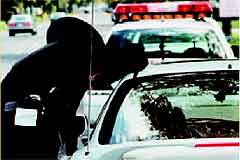In some communities patrols of officers with special training do a good job of apprehending drivers who are impaired by alcohol. This is important work, but more is needed than catching people once they’ve violated the law. It’s essential to convince impaired people not to drive in the first place. This is where sobriety checkpoints can make a difference.

“They’re probably the most effective deterrence strategy we can apply,” says James Fell of the Pacific Institute for Research and Evaluation. Where checkpoints are conducted routinely in a community - that is, on a weekly basis - they can result in a 20 percent reduction in alcohol-related fatal crashes (see Status Report, June 30, 2001 and June 19, 1999; on the web at www.iihs.org).
The trouble is, checkpoints aren’t being conducted often enough. One problem is that Idaho, Iowa, Michigan, Minnesota, Oregon, Rhode Island, Texas, Washington, and Wisconsin don’t allow checkpoints under the law. In other states checkpoints aren’t conducted because officials believe the laws could be interpreted to prohibit them. Another obstacle is that police in many jurisdictions don’t really want to conduct checkpoints.
“Police culture may be working against checkpoint implementation,” former Los Angeles police officer Thomas E. Page told a Transportation Research Board symposium in January. Officers manning the checkpoints often think of the work as unproductive, while their superiors think of it as too labor intensive. In smaller departments, police officials may think they don’t have enough officers available to man a checkpoint.
“It doesn’t have to be a big production involving 12 or 15 or more police officers,” counters Susan Ferguson, the Institute’s senior vice president for research. “This has been the norm, but it isn’t necessary to create a deterrent effect. Sobriety checkpoints can be conducted by as few as three police officers.”
Small operations yield results: Researchers at the Pacific Institute for Research and Evaluation tested the idea of conducting checkpoints with fewer officers. In two rural counties in West Virginia, three or four officers ran checkpoints every week for a year, while in two other counties checkpoints were sporadic.
The study showed a reduction in the percentage of nighttime drinking drivers in the counties with the weekly checkpoints. Compared with the other counties, 70 percent fewer drivers had blood alcohol concentrations at or above 0.05 percent.
“The lesson is that checkpoints don’t have to be large-scale operations,” Ferguson points out.
Retired West Virginia police captain J.D. Meadows agrees. He estimates that 25 or 30 agencies around the state are conducting low-manpower checkpoints. “We’re doing them constantly,” he says.
Besides deterring impaired people from driving, checkpoints can yield bonuses. They net drug offenders and car thieves (see Status Report, Oct. 29, 1994). In West Virginia a woman abducted in her pickup was rescued from her assailant when the truck was stopped at a checkpoint.
Deterrence is the goal: The effectiveness of checkpoints shouldn't be determined by how many impaired drivers are netted. The number might not be more than DWI patrols could apprehend. Instead the primary reason checkpoints are effective is that they’re highly visible, so they change drivers’ perceptions of the likelihood of being apprehended for DWI offenses. This deters them from driving while impaired.
Research has been indicating this for years. In 1984, for example, drivers in neighboring counties, one where checkpoints were conducted and one where they weren’t, responded to a survey by saying they’d be more likely to be arrested for alcohol-impaired driving in the county with the checkpoints - even though police in the other county actually were arresting more motorists (see Status Report, March 3, 1984).
A recent study by University of Maryland researchers found that experiencing a checkpoint - going through one or knowing someone who did - increases the perception of the likelihood of arrest.
“This accumulation of evidence is compelling,” Ferguson says. “It’s clear that checkpoints work and aren’t overly manpower intensive. The challenge is to get more checkpoints going in more jurisdictions so that more impaired drivers will be deterred.”
Sensors enhance checkpoint effectiveness: When police manning sobriety checkpoints use passive sensors to screen for alcohol, they’re able to detect more impaired drivers than when they rely on judgment alone (see Status Report, June 30, 2001; on the web at www.iihs.org). The sensors identify the presence of alcohol and give police an objective basis for further assessment of impairment. Using sensors also speeds up the process of going through checkpoints, which become more efficient and less inconvenient for motorists.
The Centers for Disease Control recommends increasing the use of sensors. This was one recommendation based on a review of 23 studies of checkpoints. The review confirmed checkpoint effectiveness in reducing alcoholrelated crashes and associated injuries (see Status Report, Feb 8, 2003; on the web at www.iihs.org). The reductions cited in the review were consistent despite differences in how the various checkpoint programs were conducted and evaluated. The benefits of checkpoints were found to be equivalent to those achieved by random breath testing in other countries but not the United States).
For a copy of “Low-manpower checkpoints: can they provide effective DUI enforcement for small communities?” by J.H. Lacey et al., write: Publications, Insurance Institute for Highway Safety, 1005 N. Glebe Rd., Arlington, VA 22201, or email publications@iihs.org.




